
Optimizing Product Descriptions for Better SEO Visibility
Product listing pages are landing pages in an online store. They tend to contain similar products or categories of products, and often include an image and other elements such as price, rating, etc.
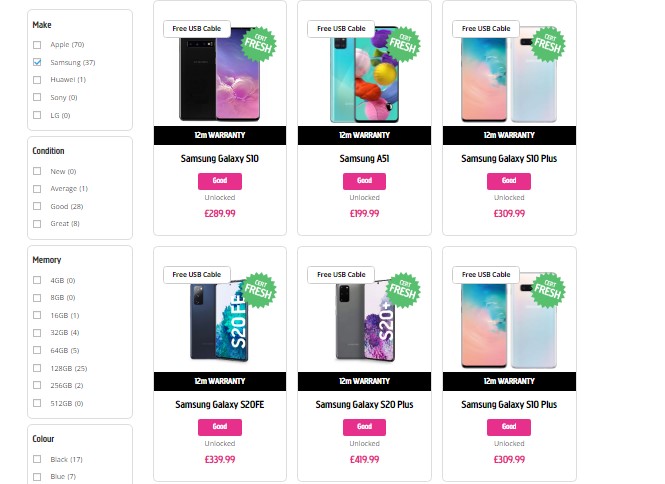
Category pages bring in the most organic traffic. Users normally search for products by known brand names, such as “Samsung”, rather than for one specific model. However, due to the high competition for these terms, it can be difficult to get a product listing page to the top of the search results. Therefore, it's important to spend time optimizing these pages, as it can have a big impact on the number of visits and sales you receive.
The optimization technique for product listing pages is very different from other regular pages that only contain a description because there are different criteria they must rank for.
This article will provide recommendations for improving the relevance and quality of product listing pages, helping to push your pages to the top of the rankings.
Use common product keywords
Product listing pages are designed to promote general product keywords. Searchers use these phrases to search for general ideas about a product, so there is no one specific product or service in such keywords. On the product listing page, a user will become acquainted with the entire range of products and be able to narrow down their options from there.
Here is an example of how popular websites such as Amazon and Home Depot display their product listing pages on Google.
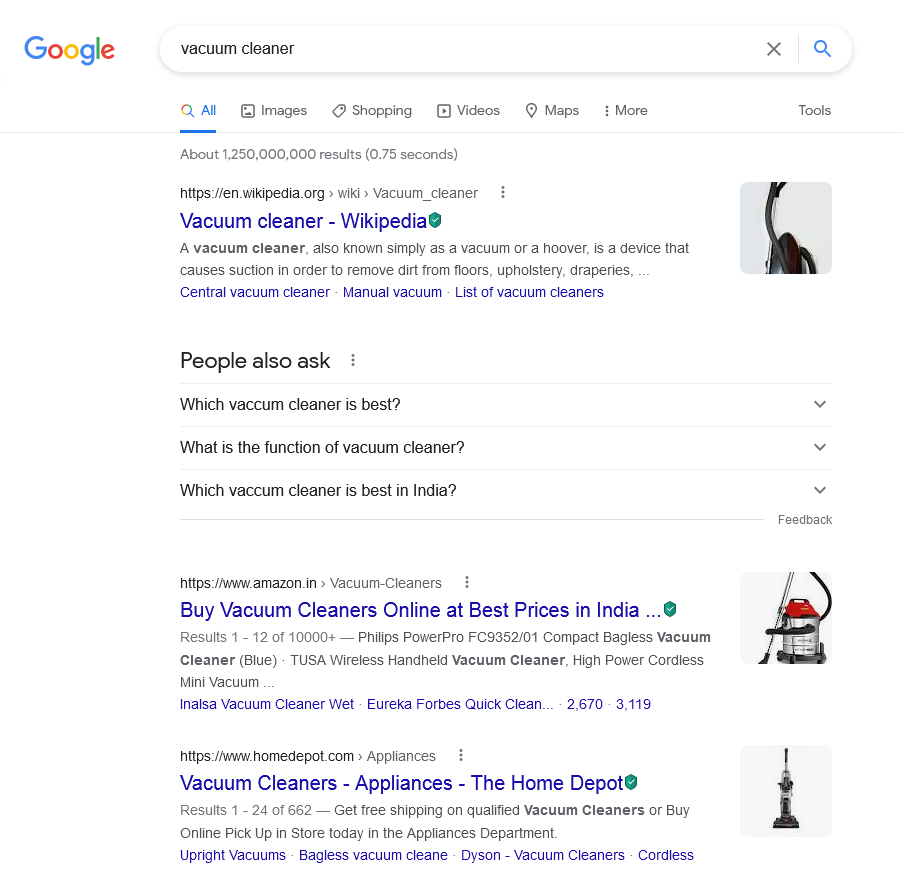
General product keywords are, as a rule, high or medium-frequency commercial-type phrases (frequency refers to how many times a month users have typed this phrase in the search).
The type of keyword is determined by the user's intent - the intention is implied in the user's search query. Commercial intent means the user intends on buying a product or service. Usually, commercial keywords contain the words "buy," "order," "price," etc. Often these types of searches specify an area in which the user seeks to buy the product/service.
Ranking for commercial keywords is useful as it brings an online store's target traffic directly to the place where they can browse and purchase goods or services.
You can read more about the different types of search intent in a separate article [here].
Labrika's tool can help you to determine the type of keyword.
Distributing keywords correctly across your pages
On Labrika, you can also perform automatic clustering (grouping) of keywords. This will allow you to select compatible phrases/keywords for product listing pages only. This can then help rank your product listing pages at the top of the results.
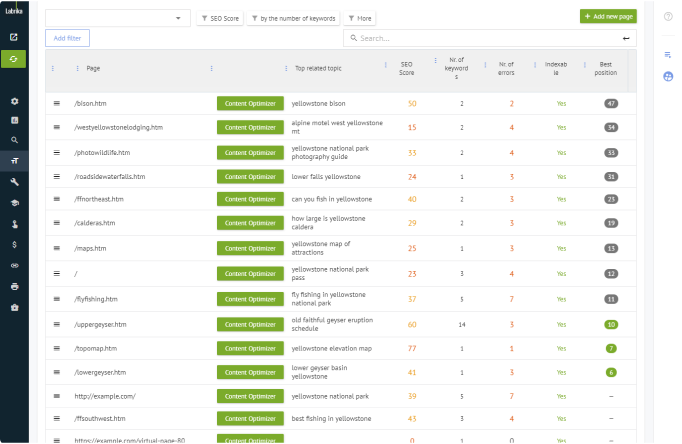
Clustering also helps avoid keyword cannibalization. This is the simultaneous ranking of several pages for the same keywords. Pages optimized for the same keywords work against your page's ability to rank. They displace each other from the search results since it is difficult for the search engine to determine which should be shown in the output for this query. As a result, these pages lose traffic and conversions.
Analyzing top competitors
Analyzing your top competitors' product listing pages allows you to evaluate and then apply these methods to your site. You should look at:
- The types of pages that display at the top of the results for your keywords. Ensure that your landing page matches this type e.g., product card, product listing page, informational article.
- The essential components of the pages: e.g., the content, the functions used to simplify user's tasks, the landing page elements such as price, shopping cart, 'buy' button, etc.
- Which pages have text, what keywords, and quantities of keywords are used in the text. Also look at the snippets (page descriptions in the search results), the title and description meta tags, the H1 header. Collect synonyms and LSI (words related to the same topic).
You can use Labrika's tools to find information on your competitor's pages such as meta-tags, headers, snippets, etc. We will then provide recommendations based on our analysis of your competitors. This means you don't have to analyze every single competitor page yourself, the hard work is done for you.
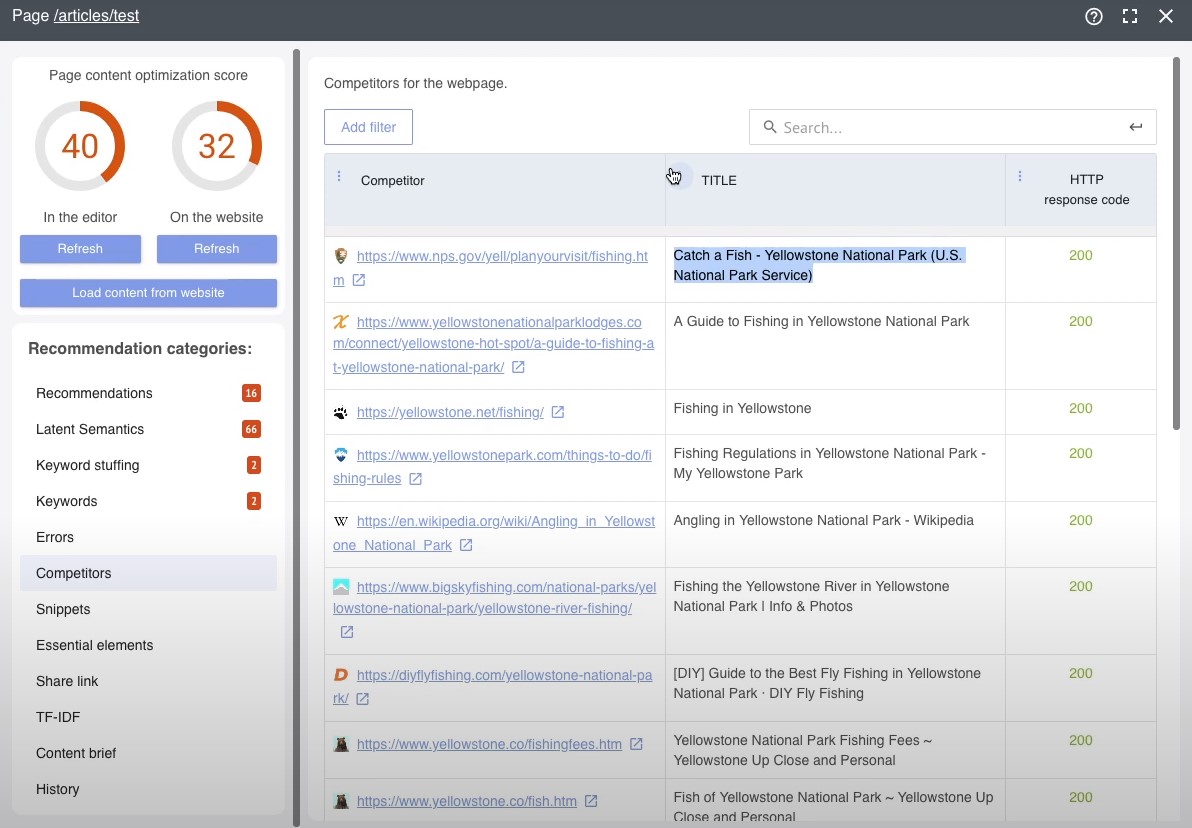
Writing and optimizing title and description meta-tags and H1
Not including, or duplicating meta tags for the title, description and H1 is a simple error that can greatly affect your ranking ability. Search engines give these elements a lot of weight when analyzing a site. For large online stores, it's advisable to set up automatic tag generation templates. Some site management systems (CMS) allow you to set these templates within their system. However, if yours does not you will need to contact a developer to implement this.
How to optimize title and description meta-tags, and H1?
- Firstly, make sure that you follow the character restrictions. The length of the title and H1 is 60-70 characters and the description is from 120 to 160 characters. You can then ensure you use the correct keyword density within these character limits.
- Do not over-optimize! Ensure you use your keywords within the recommended limits. But note that the area where you will have the highest keyword density is within the meta title.
- Use language that properly shows the page intent and will help convert users. For example: ‘buy’, ‘order’, the price, the name of the city where you sell, etc.
- Search engines often use your meta description as the snippet that will be included on the search page. It should describe the essence of the page, its purpose, and the main benefit for consumers. This means including a USP (unique trading offer) to show your competitive advantages (such as free shipping, large assortment of goods, low prices, warranty, etc.). Including any information about discounts or promotions will also increase the likelihood of a user clicking through.
You can use Labrika's online tools to get personalized recommendations (based on your top-performing competitors) on the optimal title, description, and H1 length for your pages, as well as what keywords to utilize. Our interactive visual editor allows you to optimize landing pages' text and meta tags directly on our site.
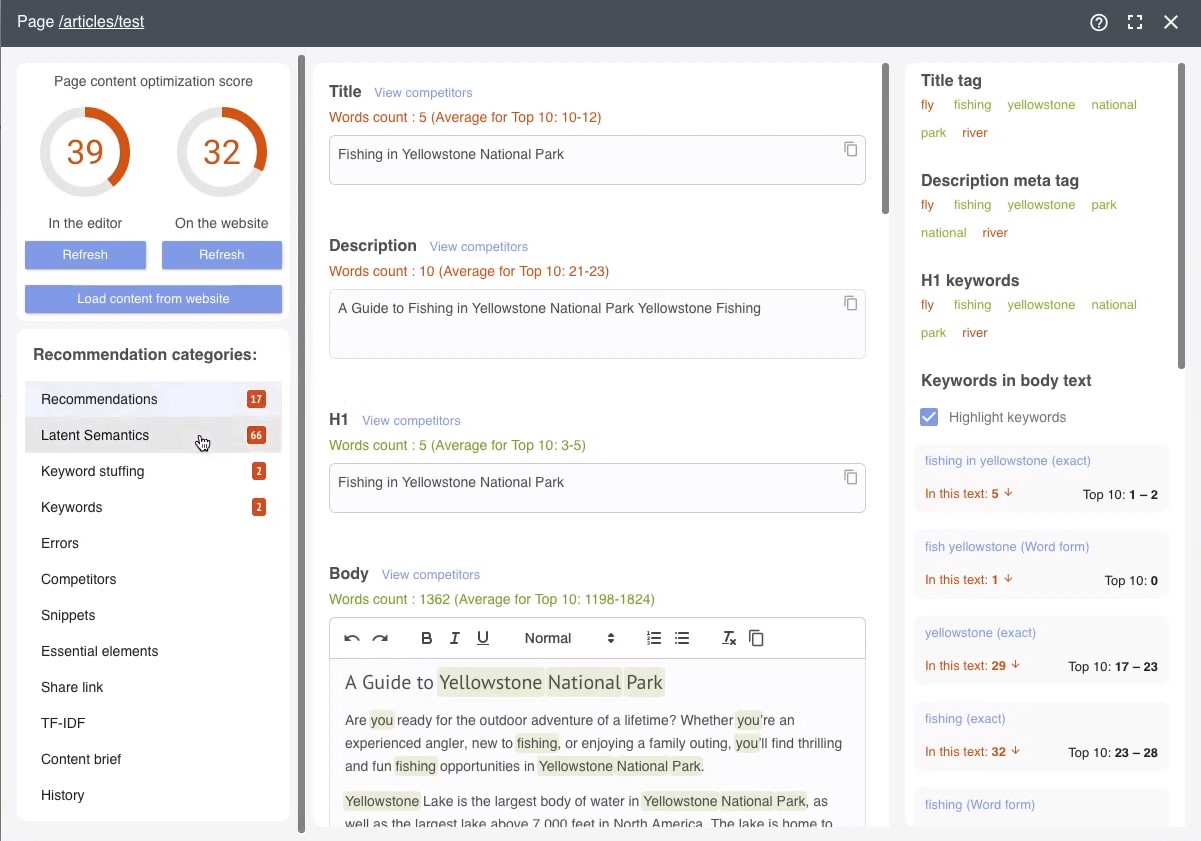
H1 heading
The H1 heading is set at the top of the page.
Normally a keyword must be placed into H1. Our tool will show whether your competitors are using keywords in their H1. This will then help you to understand how and what you should be including.
Meta title
Labrika's tool will show whether most competitors are using keywords in their titles and if so which ones. You can then use this to decide on what you will include in your product listing page titles.
The title should be unique to each product listing page, it should be readable and informative. Keywords should always be used, but they should not be 'stuffed' in. Using long-tail keywords may be useful for titles.
Different punctuation can be used to separate the words in the title (apart from underscores) this will then help to make the title more readable for the user at a glance.
Bear in mind that the first keyword in the title has the most significant weighting. Don't use several similar keywords in one title, as the search engines may view this as keyword manipulation. Instead ensure you use your keywords in a natural manner, where the sentence makes sense to the user.
Meta description
You should be using keywords that you have selected after analyzing your competitors' pages. However, you shouldn’t be repeating keywords that have already been used in the title or H1. You can include a longtail keyword if it fits.
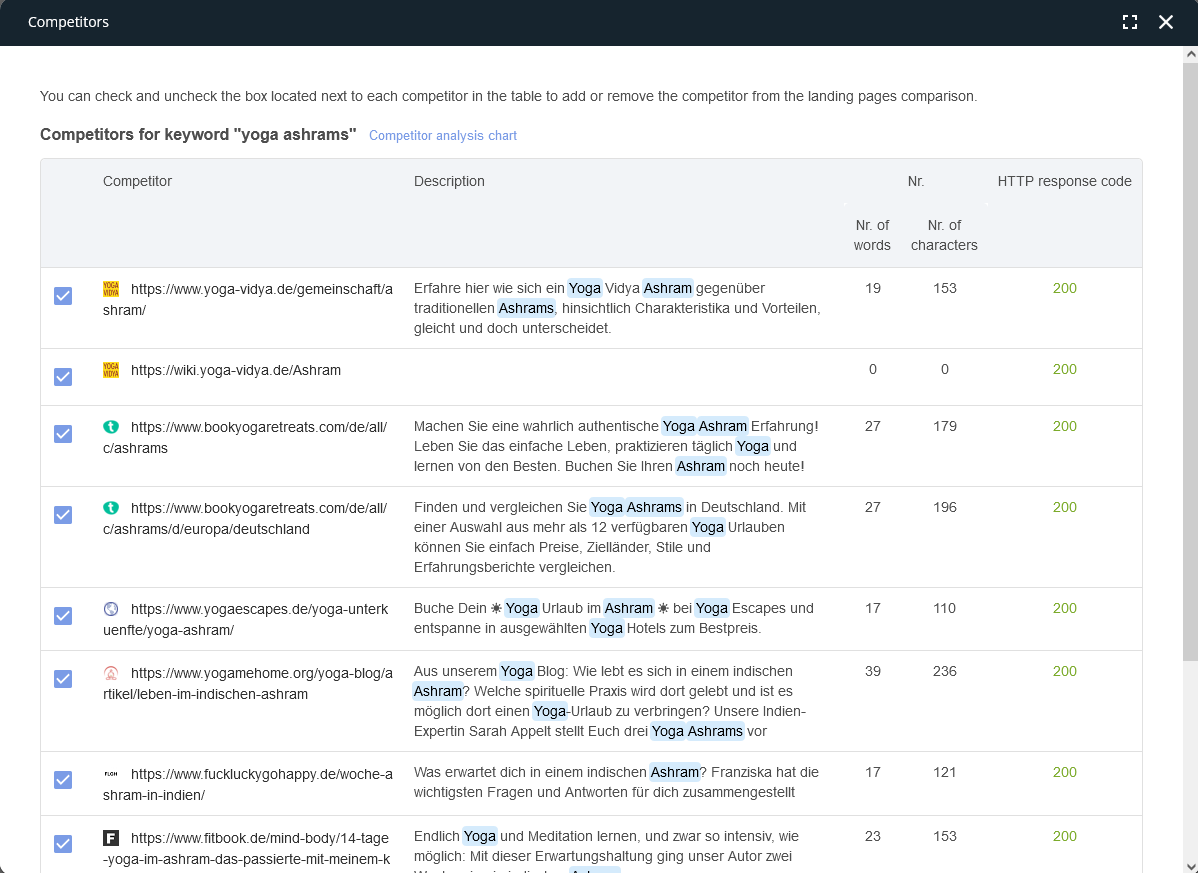
This description will be one of the first things a user sees in the snippet, when on the search results page, so it should be as attractive as possible for the search engine and the user. This means that the text should be easy to read and allow the user to understand quickly whether they’ll find what they need within the site.
The don'ts of meta-tag and header optimization
Do not try to artificially increase the page's relevance by using overly-optimized text, filled with keywords that’s unreadable and non-useful for the consumer. Firstly, a user will be less likely to click through, and secondly, search engines may classify this as spam and demote your page.
The article should be natural and readable, containing beneficial information about the product and how to purchase it.
To summarize:
- To attract customers, make sure to specify the advantages of your product/offering.
- Create unique descriptions even for similar products.
- Use Labrika's recommendations to correctly determine your text volume, optimal keyword density, as well as LSI (latent semantic indexing).
How to optimize Body text?
Very often product listing pages will not include body text. The information needed to help rank the page is provided in a multitude of other ways, such as:
- Keywords and synonyms in H1, title, description meta-tags.
- Keywords in links to product listing pages where the brand name is in the product name. For example, for the keyword "Samsung phones" there may be 30 links with product names such as: "Samsung Galaxy 21 256Gb blue", "Samsung Galaxy 21 Ultra 512Gb gray", etc. Here the keyword Samsung is already in almost every link on the page, and the LSI/mentions of "Cell phones" in the page's breadcrumbs are enough for search engines to determine that this is a phone product listing page.
- Keywords in anchor links, inside and outside of the site.
- LSI. For example, take the keyword "Samsung phones", there may be landing pages where the term "Samsung" is not included for each phone. However, if the names of the most popular models are included and linked to on the page, such as "Galaxy 21", this may still fall under LSI as it is one of the most expected terms we see linked to "Samsung".
- LSI will also help determine additional information on the page – about delivery, warranty, etc., as well as filters used by users.
- User behavioral factors. Sites that keep users' attention for longer perform better in the rankings, as they are deemed to be interesting and more likely to be relevant to the user's needs.
- A large choice of products – the more, the better!
- Ensuring the necessary elements are on the page. If the query intent suggests that the user will want to see a price and 'buy' option, then ensuring these elements are available is key to a place in the top 10. You can view the report: 'Essential landing page elements' on Labrika to find out more.
- Before deciding on whether you need a block of text on your page, look at what your competitors in the top 10 are doing and create similar content!
Here is an example of a product listing page for "Mobile phones" that doesn’t include text blocks:
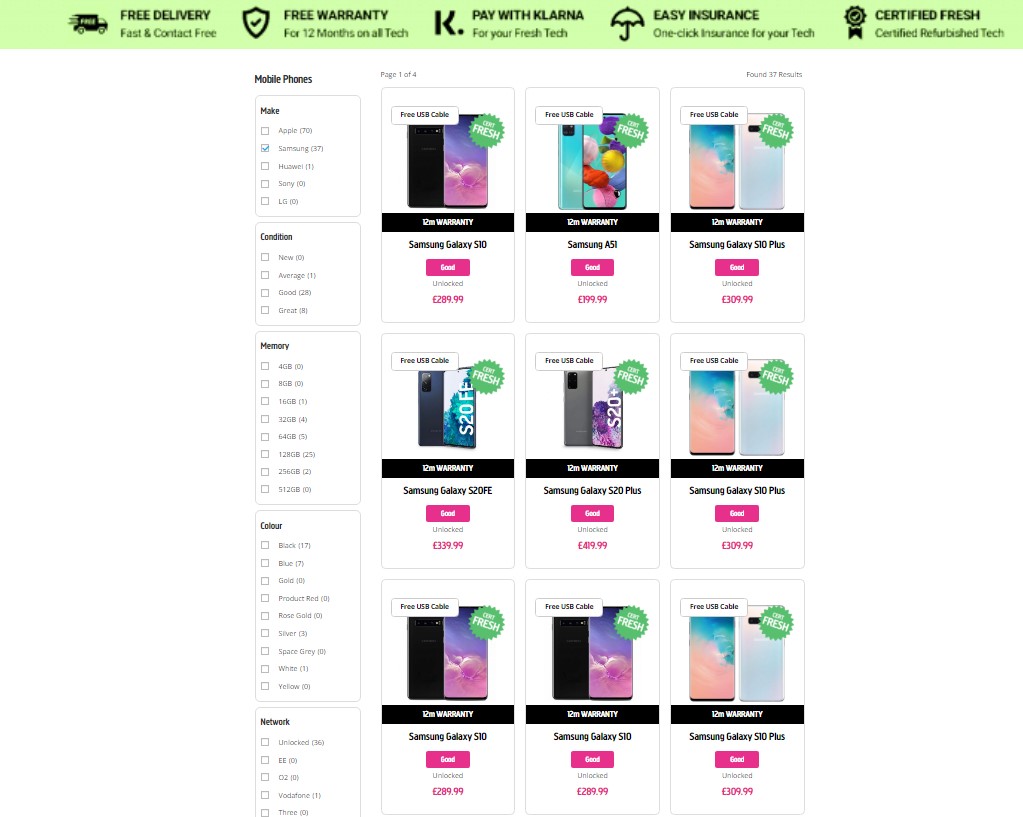
If you do have text blocks on your product listing pages currently, you can remove them once you know you have the right number of keyword occurrences, even without the text block there.
You should ensure your keyword occurrences remain the same as your competitors. It's also useful to keep an eye on your position in the rankings to see how the removal of these text blocks affects your position.
To summarize:
- Look at how many products are on competitors' product listing pages, as well as how often they use keywords in links to detailed product descriptions.
- Do they have text descriptions (without links) for their products and if so, what is the text length?
- Make sure you match your competitors for the number of products in a category, not only on the first page but on the second, third, etc. More choice is normally better for the user.
- Check that you have all your products in stock, the price is visible and there is a 'buy' option, as well as a basket.
- Check all required landing page elements. (You can use Labrika's essential landing page elements report for this).
- Plan how you will use LSI. Some LSI keywords will be in the menu and filter options for the list of products. For example, there may be wording on warranty or delivery, if you do not have this, add it. Other useful keywords for LSI may be in the name of the products. If we take the example of cell phones these may be the most popular brand names such as "Samsung". Therefore, if you aren't keeping your store up to date and showing brand names that are in demand you may also lose ranking opportunities.
- Don't forget to check meta tags and heading optimization on Labrika.
- Come back after a month to check how your product listing pages are doing. You should see a marked improvement in behavioral factors and rankings.
Increasing your product range
A major deciding factor in the ranking of your product listing pages is how many products you offer in a range. Sites that offer more tend to rank higher since they tend to better meet the consumers' needs.
For example, if you offer 5 products within a category, but a competitor offers 5000 it is highly likely that the competitor will have an advantage. For this reason, we recommend maximizing the number of products on the product listing pages to better compete with your competitors.
Optimizing product cards
Name and description
To make the product cards more informative to the user you can create a more in-depth product card. For example, you can include the model name, type of product, main characteristics, etc. This will also allow you to keyword optimize your content and take advantage of LSI, as well as simply offering a more useful experience to the user, making it easier for them to decide on which product they need from the product listing page.
Images
The product photos in the product cards must be the same size and taken from the same angle. The images should clearly represent the product.
You can include keywords in the description of the pictures. Search engines index and display images with the ALT attribute in a separate search tab.
Pricing
Showing the price of a product is not only useful for your user, but also search engines. A product normally comes with a price, therefore not showing one, indicates to the search engines that you haven't put proper thought into your site (this is a red flag to search engines). If your competitors are including pricing but you aren't then this will negatively affect your ranking.
The "buy" button
The buy button allows the user to immediately buy the product or add it to the cart. This is a vital element to any product card, as without it the user cannot easily purchase your product.
If you have the option to add a 'buy it now' function this can be a very attractive prospect to many potential buyers who would prefer to avoid going through the shopping cart process every time.
Additional functionality
There are various additional functions that a site can offer that many customers may find useful, such as:
- The ability to compare multiple products or add items to a favorites list.
- A quick view of the product page with additional product information that pops up when you click on the card or hover the cursor over it.
- The option to filter by different parameters such as color, size, price, etc.
- The ability to enlarge an image. This is essential when a product is being chosen for its appearance, such as an item of clothing or furniture, etc.
What to do with products that are out of stock?
Products that are not currently available should be displayed at the end of the product list. Instead of the phrase "out of stock," you can use the term "on order" and offer the possibility of pre-ordering if the items are only temporarily out of stock. If you use more competitive pricing on the product cards that are temporarily out of stock this will attract visitors and improve user behavioral factors.
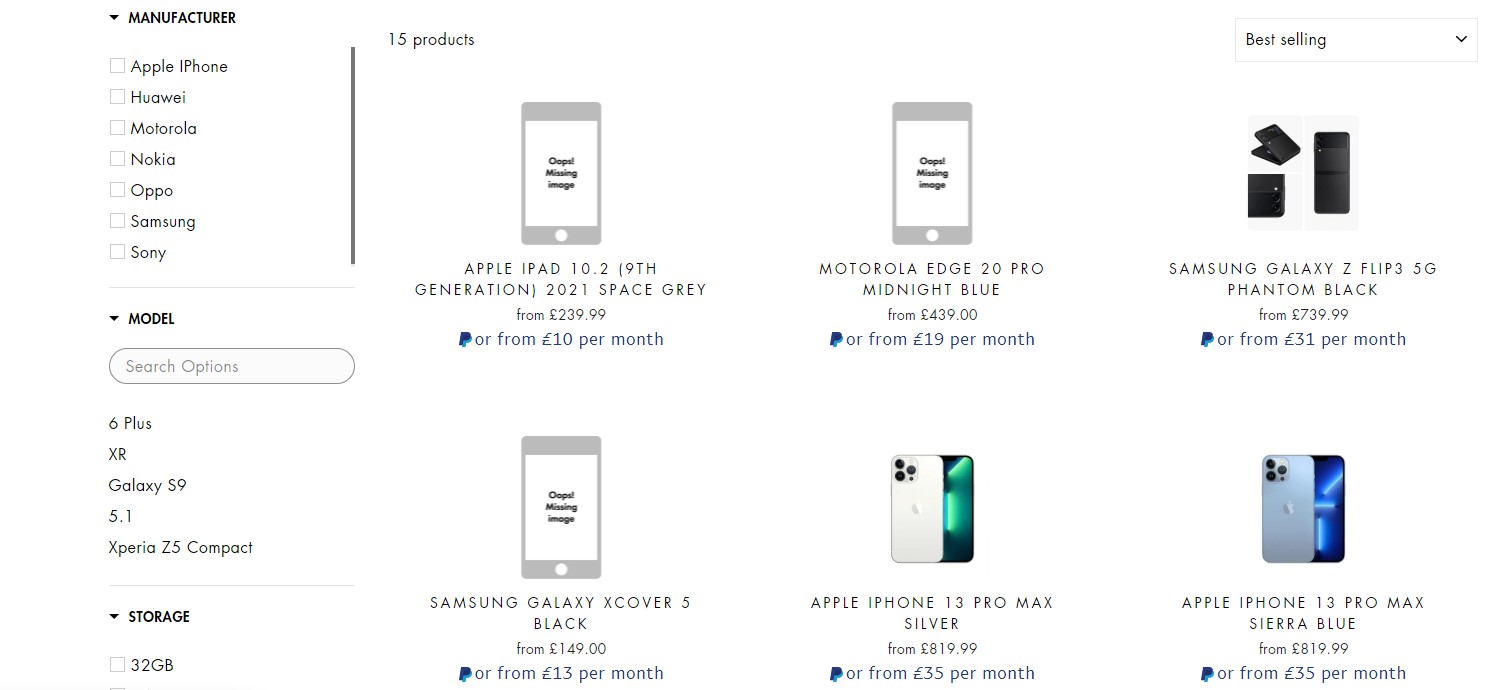
Promotional products
Make sure to put any promotional products at the top of your product listing pages as these are the items that are most likely to catch a user's attention. You should include information on the promotion within the product card such as the promotional price vs the normal RRP (recommended retail price).
User ratings
You can display a rating markup on the product cards. Place the higher rated products first. Consumer opinions will help other buyers make a decision and also increase trust factors.
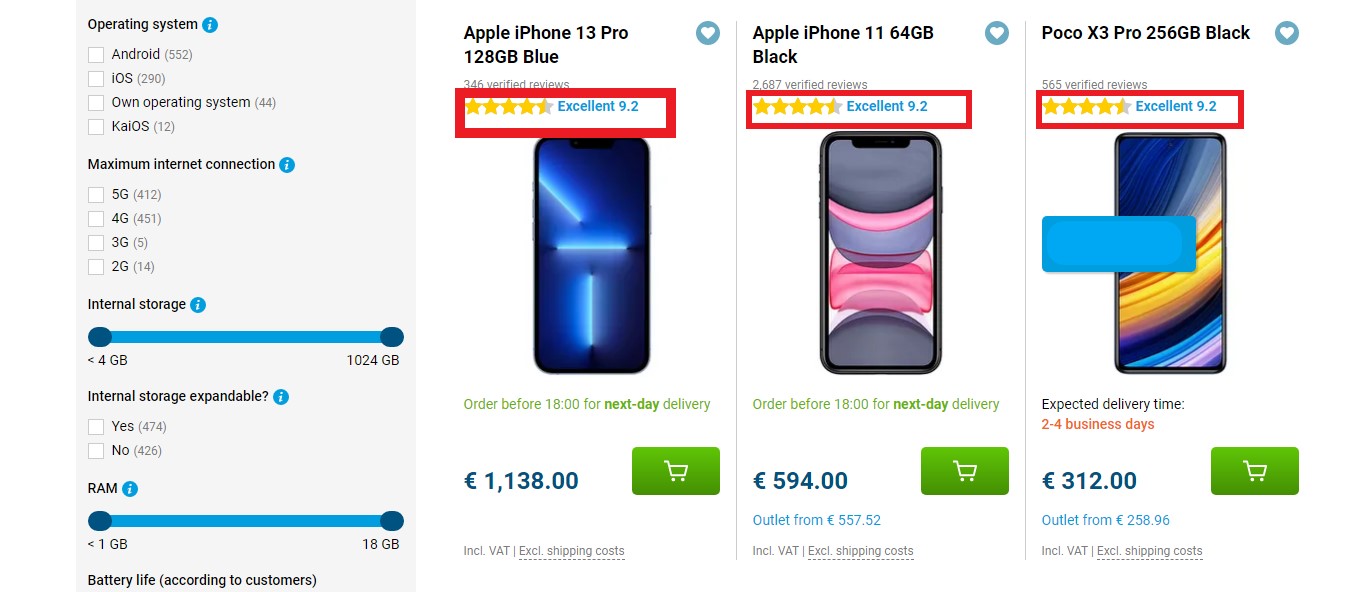
Configure pagination correctly
If there are a lot of products in a list, then placing them on one page is impractical. Firstly, the user will get tired of scrolling through a long page, and secondly, it will be technically difficult for the site to load all the products at once. In this case, use pagination – this splits the products into separate web pages.
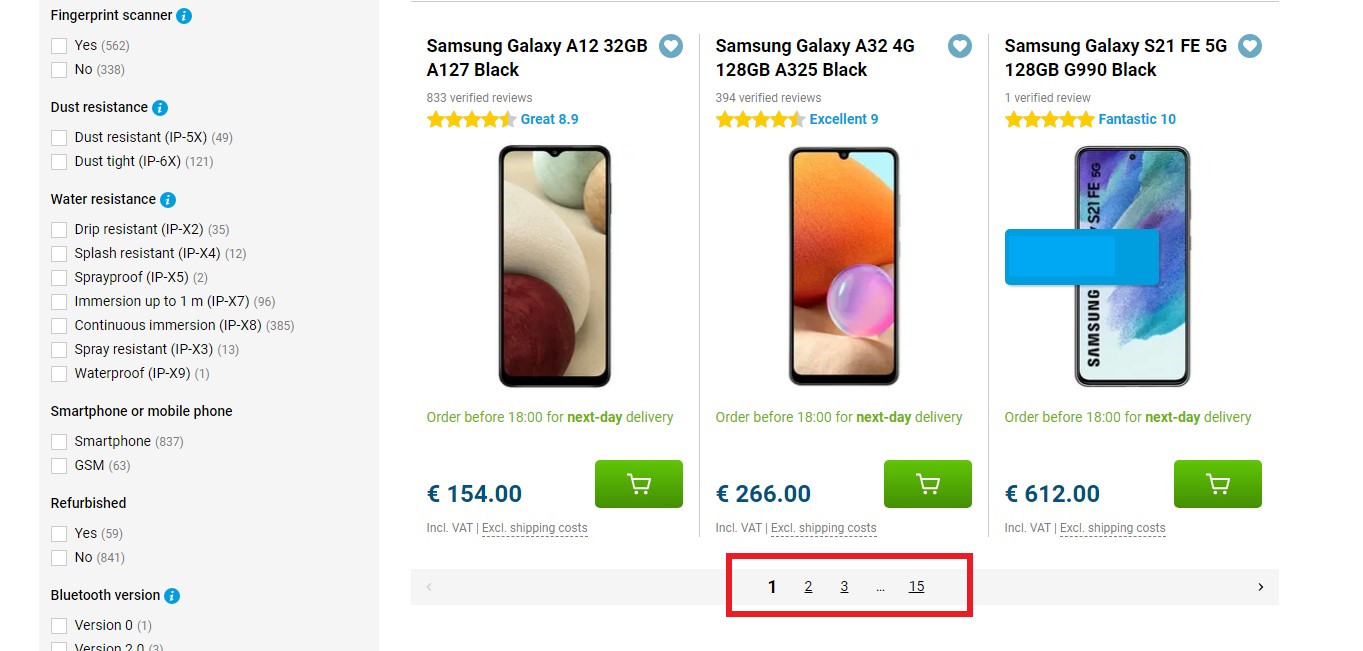
Since most content management systems (CMS) assign the same data to the main page and any subsequent ones, it is normally pagination that causes page duplication.
To avoid this, do the following:
- For Google, it is recommended to specify in the attribute rel=" canonical" either the page where the product’s registered or the main product listing page, where all the products are displayed at once.
- Only add SEO text to the main product listing page, but not to pagination pages.
- Register the pagination page number in the meta title header to make it unique – an example is shown in the screenshot below.

We don't recommend blocking pagination pages from being indexed by using a rule in the robots.txt file as this will also stop the content from being indexed.
If you use infinite scrolling instead of pagination you must ensure that all content on these pages is indexable.
However, when it comes to e-commerce sites, we tend to recommend using pagination rather than infinite scroll, as it gives the user more control when looking for a specific item. Infinite scrolling tends to be more useful for social media sites where there is not one specific item that the user may be looking for.
Add the necessary essential landing page elements
Search engines evaluate commercial resources based on particular characteristics. These tend to be elements that ensure convenience when purchasing a product or a service and increase customer trust and loyalty.
The necessary elements can change depending on your site type. However, some elements are compulsory for any site that has commercial intent. If you want to find out more, you can check out our essential landing page elements report in our dashboard. This will analyze your top 10 competitors' sites and provide information on what you need to do to compete.
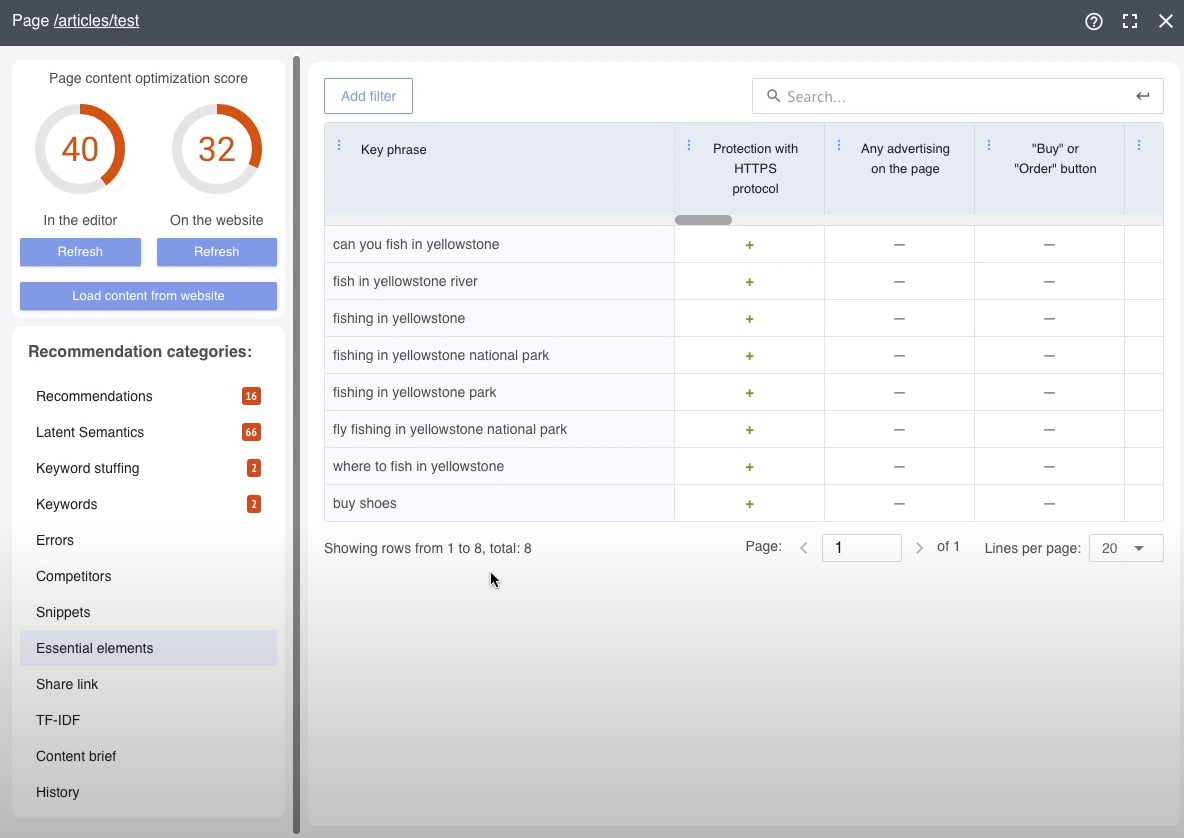
Improve the Usability of the page
Simplicity and ease of use are the main factors directly affecting online sales and user experience. Create pages with an intuitive and simple structure, easy navigation, an attractively designed CTA (call to action), and a valuable offering.
Work out how you will configure your clickable elements. Buttons, links, banners should be optimized with understandable/ clear call to action wording, such as: "buy," "go," "issue."
Don't use annoying ad formats and intrusive pop-ups that get in the way of users using your site.
Use filters
Filters are an essential part of any commercial resource. Being able to filter through products contributes to improving a site's behavioral characteristics and therefore sales, as a user feels more comfortable in finding the product that's correct for them. The filters must correspond correctly to the products within them, be understandable and user-friendly.
Ensure you include as many parameters as possible in your filters, such as colors, sizes, material, price, brand, review ratings, etc. Firstly, it's more convenient for users, and secondly, it helps create more relevant product listing pages on your site. Additional landing pages are created under these filter categories, this attracts search traffic for low-frequency queries.

You must ensure that any non-useful pages will not appear in the index during the filtering process. To do this, ensure that any of these pages, when found, are blocked from being indexed.
Have a good internal linking scheme
Internal links show how pages are linked to each other and help users and search robots navigate the site.
Placing links to other internal pages with helpful content improves user behavioral factors. It keeps visitors on the site longer, motivates them to navigate through more of the site, and encourages them to actively interact with the site's elements and make additional purchases.
Place links to product listing pages in product descriptions and informational articles. Multiple links to a product listing page indicate the importance of its content to the search engines, therefore helping increase the page's ranking.
In addition to links to product listing pages and product pages, you can also use cross-content linking to pages that may be potentially interesting to the user. For example:
- "Popular products"
- "People often buy"
- "Recommended based on your views"
- "Novelties" etc.
- “Related products”
These lists allow users to see small snippets of other relevant or interesting products that may be of use to the user, yet again encouraging good user behavior by keeping them on the site longer.
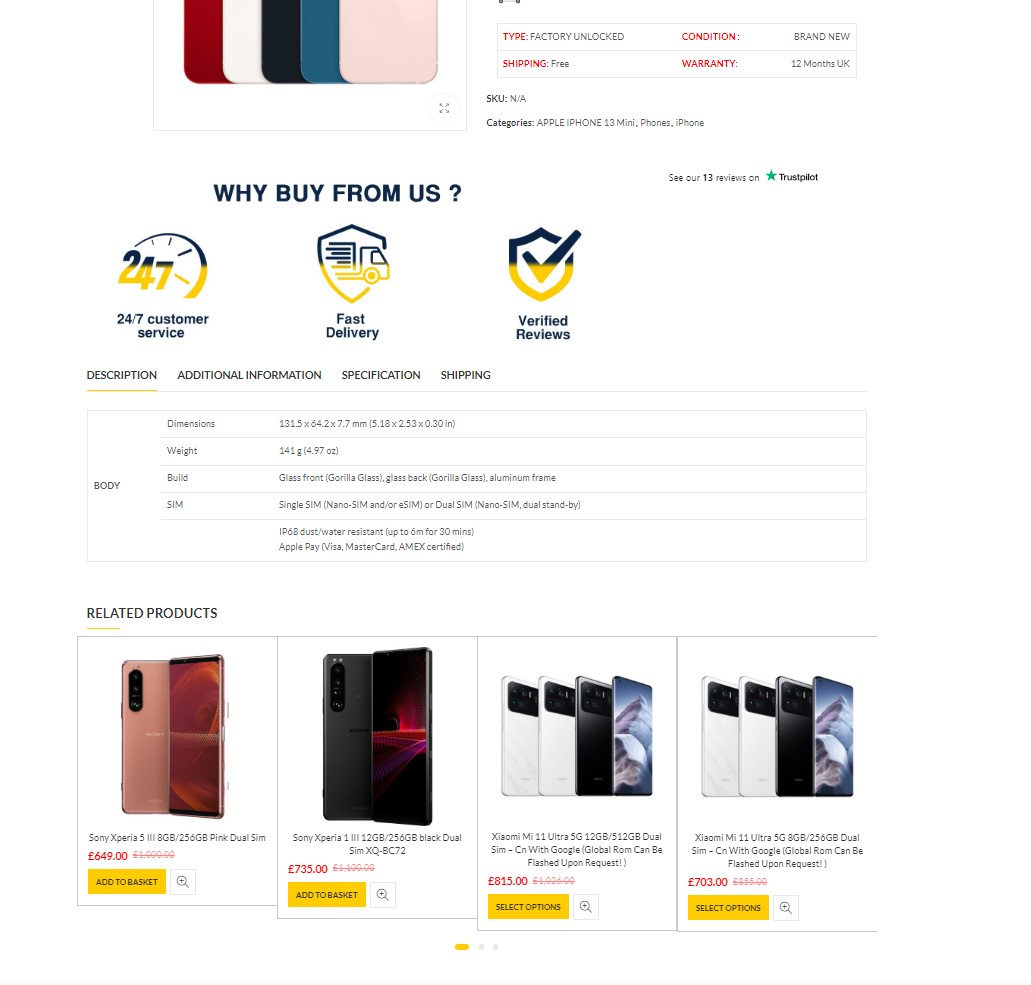
Create a tag cloud
Tagged pages are a kind of pseudo-product listing page in which products are combined according to specific narrow criteria. The set of properties based on which the tag is formed should correspond to popular user queries.
Pages that contain products with a popular combination of characteristics tend to be included in the index, rank well, and bring a lot of search traffic.
If your product listing page can be divided into such tags, link to them as you can see has been done below. However, it is essential not to overuse keywords on the page when creating tags as this can be seen as a spam tactic by the search engines.
The screenshot below shows an example of placing a tag cloud on the product listing page "Garden and Outdoors".
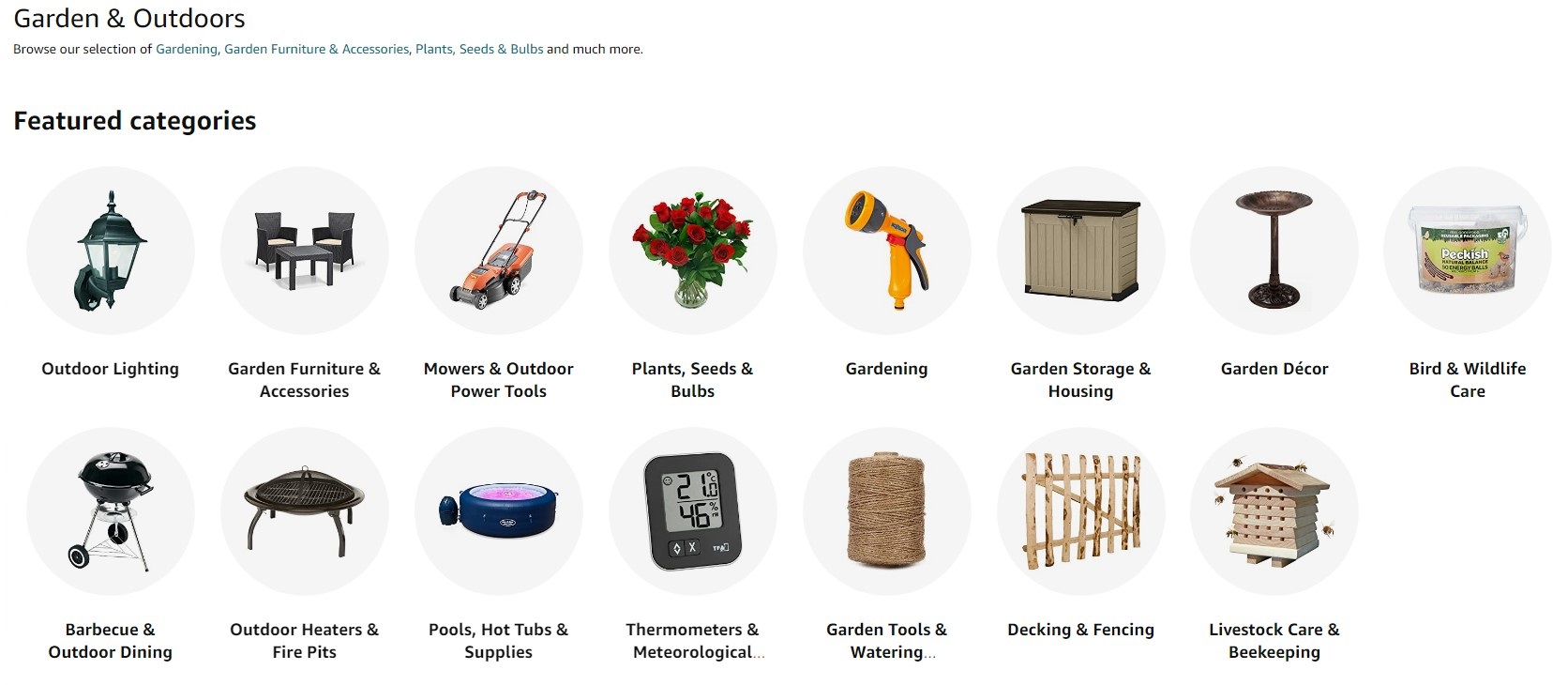
Use additional navigation
The primary means of navigation on product listing pages (menu sections, internal links) should be supplemented with 'breadcrumbs'. These are navigation chains (as you can see below) that reflect the sequence of pages from the main page to the one where the user is currently located.
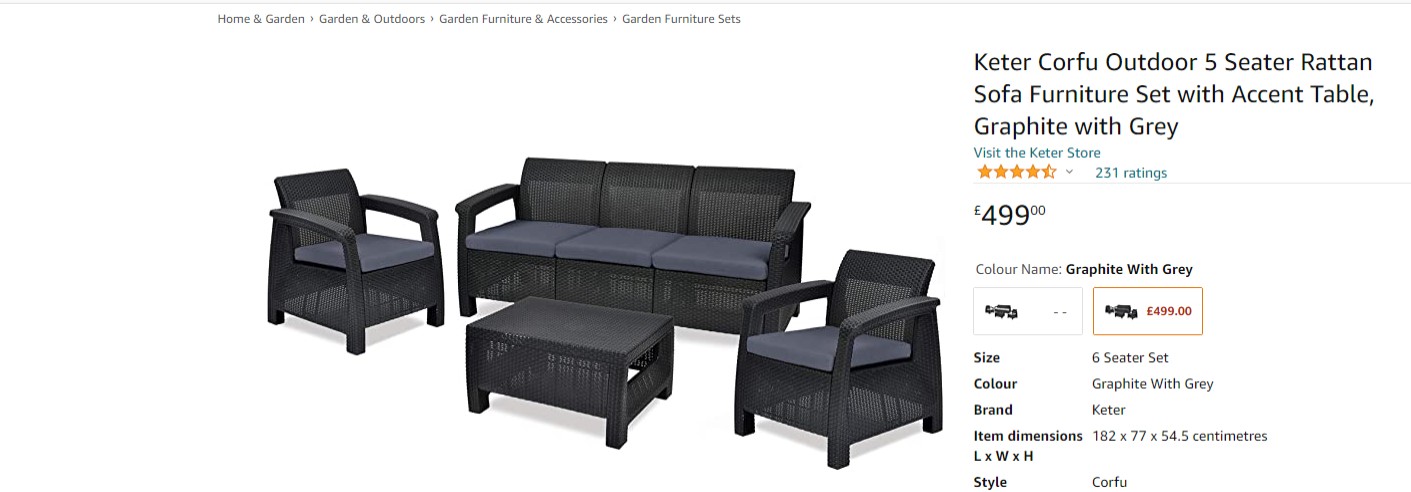
Thanks to the clickability of each link, breadcrumb chains not only help to navigate the site but also to quickly return to a specific page in the chain.
This element is also displayed in the snippet, as seen below. This makes it clearer to the user that they will be clicking through to a relevant page.

Create Search Engine Friendly URLs
Ensure the product listing page's name is relevant to the content within. The presence of a search engine-friendly URL will help the user immediately understand what product they will find on the page making them more likely to click through.
The keyword content in the URL can help increase the page's relevance to the query. However, including an excessive number of keywords can lead to spam and an increase in the URL length. Shorter, simpler URLs are preferable as they are easier to read and remember.
Check any technical aspects.
Make sure you have all your bases covered by checking for any technical errors that can reduce your site's effectiveness. Even simple technical errors can stop a page from ranking, or even being indexed in the first place.
- Download speed is also a major ranking factor and impacts user behavior. If the page takes longer than 2-3 seconds to load it's worth taking measures to speed up your site.
- Use the HTTPS secure data transfer protocol. This is already becoming a prerequisite for being able to compete with the top commercial sites. User security requirements for the data being processed or held are exceptionally high and having HTTPS has now become key.
- Ensure your site is mobile-friendly. This means having a specially adapted version of your site for mobiles that clearly shows the content on the page and has fast loading speeds. Search engines now take a mobile-first approach, meaning if your site isn't mobile-friendly it's unlikely to rank well!
You can conduct a thorough and quick technical audit of your site from our dashboard. We check 68 different technical parameters on each site, meaning we can find any small errors that may be holding your site back.
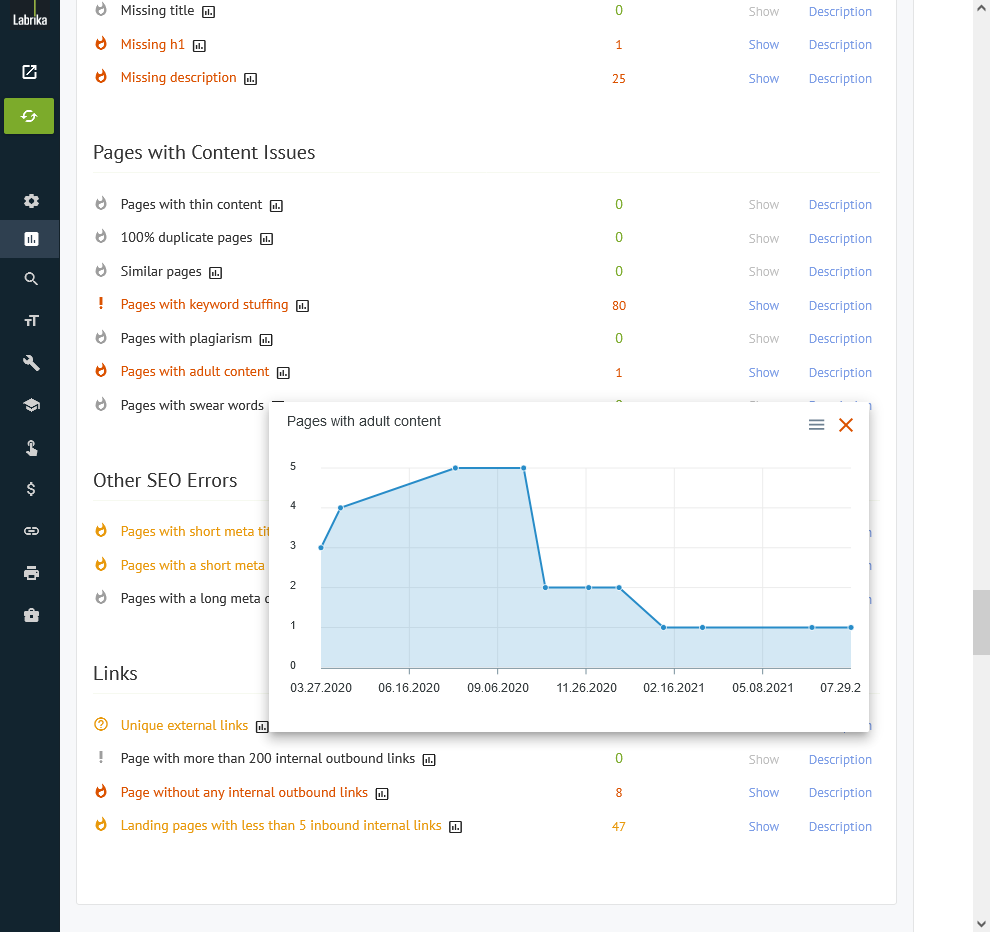
It's important to remember that search engine optimization is not a one-time event. SEO is a continuous process. To continue to see good results you must regularly analyze results achieved and refine where needed. Fill your site with valuable and relevant content and consistently compare against your competitors in the top 10 to ensure you are maximizing your opportunities.
Run a comprehensive SEO audit from our dashboard here at Labrika to receive personalized recommendations based on over 200 ranking factors, and to get a comprehensive overview of what your competition is doing to get in the top 10.
